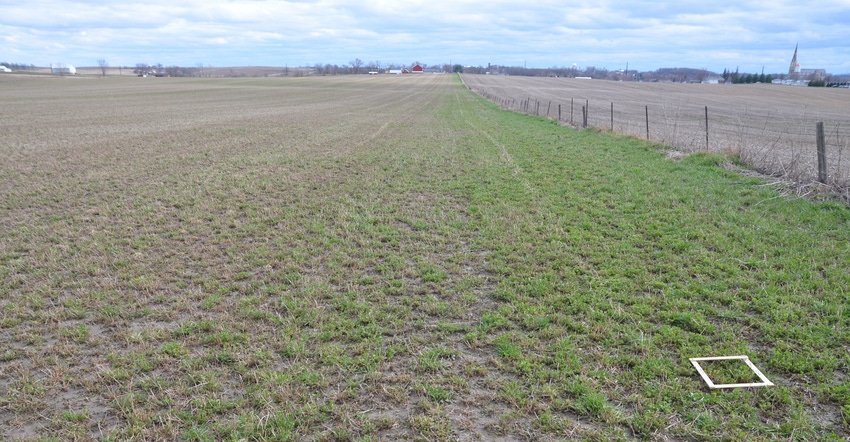March 22, 2017

A warm weather pattern in late February caused soil temperatures across most of Iowa to rise above 40 degrees F. It was likely warm enough, long enough for alfalfa and some forage grasses to break dormancy. Forage grasses of concern include most ryegrass varieties, and the less winter-hardy orchardgrass and tall fescue varieties.
When cold weather returned in March, farmers who have alfalfa and other forage stands wondered about possible winter injury. Brian Lang, Iowa State University Extension field agronomist at Decorah in northeast Iowa, has dealt with this question a number of times over the years.
“When low temperatures recur, alfalfa plants can reharden to a degree, but only to the extent that the plant still has stored carbohydrates available,” he explains. “Winter injury occurs either with enough warm-cold cycles to use up the carbohydrates, or if the temperature drops so rapidly that the plant does not have time to sufficiently reharden.”
When dormant, alfalfa crown tissue can tolerate soil temperatures down to about 5 to 10 degrees F, to where tissue damage could then begin to occur, says Lang. After breaking dormancy, tissue damage could theoretically start to occur at about 30 degrees F with some plants, but more likely not until soil temperatures get down into the mid-20s for alfalfa crown tissue to be damaged.
Management makes a difference
If shoot development occurred with a break in dormancy, and the air temperatures later on are cold enough to freeze these shoots, the plant can initiate new shoots as long as sufficient carbohydrates are available. “As carbohydrates are depleted, tissue damage will occur,” notes Lang. “If too much damage occurs before the plant can photosynthesize and produce carbohydrates, the plant will not recover.”
Seasonal alfalfa management influences how well plants store carbohydrates entering into the winter. These factors include variety selection (winter survival index, disease resistance, fall dormancy level); age of stand; soil fertility; pest management; soil drainage; soil moisture in fall (higher soil moisture in fall tends to reduce alfalfa hardiness for the winter); last year’s cutting schedule intensity (how much stress was put on the stand); whether or not there was a late fall cut; and if cut late, whether or not there was fall stubble left. “These are all issues dealing with stress management and how healthy the stand enters into the winter; thus, winter injury conditions between and within fields can vary considerably,” he says.
Judge by tissue firmness, not color
The current cold front in mid-March may cause some wide-scale problems with alfalfa, ryegrass, and the less winter-hardy varieties of orchardgrass and tall fescue, “but we need to take a wait-and-see approach, and scout fields,” Lang advises. Scout by digging plants starting about a week after the cold front passes. This will provide some time for the crown tissue to start showing its true nature — firm tissue is good, soft tissue is not.
If this current weather causes tissue damage, there should not be any visual tissue discoloration yet (first off-yellow, then tan in color) since it’s too soon after the freeze damage. “You should judge by tissue firmness, not tissue color,” says Lang. “If by chance the crown tissue is discolored and soft to mushy, damage to the plants likely occurred weeks ago. If crown tissue is dead and drying out, the plant damage occurred at least a month ago.”
Most plants in older stands will also exhibit some dark-colored crown rot in the center of the crown, which is normal. Ignore this and evaluate the white tissue surrounding this area. Check the illustrations in the University of Wisconsin publication (A3620, mentioned below) to aid in your assessment of the stand.
Guidelines to evaluate stands
Scouting and stand assessment could end up being completely obvious, with either everything or nothing greening up, says Lang. However, he says you should also be aware that it is possible for winter-injured alfalfa to initially green up to some degree with its remaining stored carbohydrates, to the extent of a few inches of shoot development, even though the crown tissue is too severely damaged for the plant to survive.
At this time (mid-March), it’s too pessimistic to discuss replant options. “Let’s first scout the fields,” advises Lang. “Listed below are resources to assist with plans to conduct alfalfa stand assessments, as well as to plan your livestock forage inventory — and considerations for forage replant options, if it comes to that.”
• University of Wisconsin A3620, “Alfalfa stand assessment: Is this stand good enough to keep?”
• University of Minnesota article regarding alfalfa winter injury, forage inventory for livestock, and forage replant options: extension.umn.edu/agriculture/forages/growth-and-development/winter-injury-of-alfalfa
• Iowa State University article discussing forage replant options: crops.extension.iastate.edu/cropnews/2008/04/adapting-alfalfa-winterkill-and-winter-injury
Source: Iowa State University
You May Also Like




